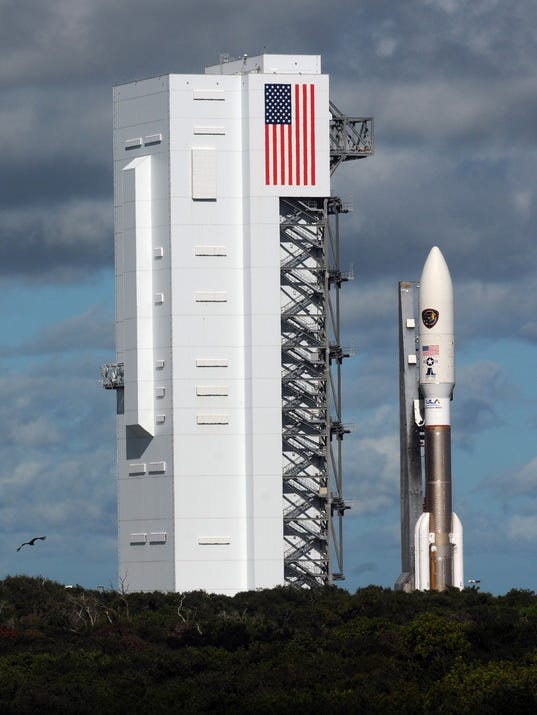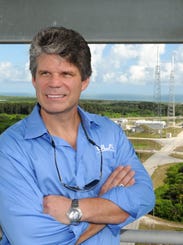Results 1 to 1 of 1
Thread Information
Users Browsing this Thread
There are currently 1 users browsing this thread. (0 members and 1 guests)
-
09-17-2013, 12:46 PM #1
Air Force satellite expected to launch early Wednesday
Air Force satellite expected to launch early Wednesday
Todd Halvorson, Florida Today 12:28 p.m. EDT September 17, 2013
Atlas V rocket was rolled to launch pad Monday morning.

An Atlas V rocket, which will carry an Air Force communications satellite, is rolled out Sept. 16, 2013, to its launch pad at Cape Canaveral Air Force Station.(Photo: Tim Shortt, Florida Today)
Story Highlights
- Launch window for military satellite is 3:04 to 5:04 a.m. Eastern Time
- The $500M satellite is the 3rd of 6 new satellites the military will deploy to replace older models
- Forecasters expect a 60% chance of acceptable weather
CAPE CANAVERAL, Fla. — Space Coast residents will get an early wake-up call Wednesday with the expected launch of an advanced military communications satellite.
Standing 197 feet tall, a powerful United Launch Alliance Atlas V rocket carrying the satellite is set to blast off at 3:04 a.m. ET from Cape Canaveral Air Force, the beginning of a two-hour launch window.
STORY: Satellite set to launch from Fla. after sunset
PHOTOS: Satellite launches from Cape Canaveral
Months and months of work will climax at 9 minutes and counting — when the $500 million satellite switches from launch complex electrical supplies to internal batteries. The payload will be operating on its own — a status that spacecraft integrator Joseph Fust, who is responsible for making sure all pre-launch work with the Air Force satellite meshes with rocket preparation, will report on Tuesday.
"There's always worry that the launch vehicle might have some issue, and there's always the threat of weather," said Fust, 55, of Merritt Island, Fla. "But when all of that is clear, and you get all those 'ready' calls at 9 minutes to go, you sit back and watch the show."
The overnight show Wednesday will feature an Atlas V rocket equipped with a 5-meter payload fairing and three strap-on solid rocket motors. The 67-foot-tall motors augment first-stage engine thrust for 92 seconds and then are jettisoned from the rocket a little less than a half minute later.
On a clear night, spent boosters look like orange embers tumbling toward the Atlantic Ocean.

Spacecraft integrator Joe Fust, 55, of United Space Alliance at the Vertical Integration Facility where an Atlas V rocket is to launch an Air Force satellite Sept. 18, 2013.(Photo: Tim Shortt, Florida Today)
The two-stage rocket is scheduled to deliver the satellite to an initial operating orbit about 51 minutes after launch. The Air Force's Advanced Extremely High Frequency communications satellite will use onboard propulsion systems to nudge its way into an orbit 22,300 miles above Earth. It's the third of six new-generation communications satellites that are 10 times more capable than the constellation of Milstar spacecraft they are replacing.
Bringing together the pre-launch satellite schedule with the Atlas V processing flow is a job that involves people from Cape Canaveral to Colorado and California.
People in three time zones come together and shoehorn satellite tests and procedures into a busy rocket-processing schedule, making certain everything culminates with the spacecraft switching to internal power when countdown clocks reach that 9-minute mark.
"The spacecraft schedule and the launch vehicle schedule, they are like gears, and they've got to mesh together happily. You don't want to grind them," he said. "Everybody has got to be headed in the right direction at the right time, and that's a bit of a challenge."
The third of five siblings, Fust remembers his earliest experiences with rocketry growing up on Long Island, N.Y. At age 7 or 8, he would assemble model rockets with his brothers and launch them at a nearby elementary schoolyard.
<!--iframe-->
The Fust brothers manned their rockets with small tree frogs or bugs "to see if they would survive the ride," he said.
They didn't. But the launches ignited an interest in aeronautics, and Fust went on to earn a degree in mechanical engineering from Penn State University in 1982.
Fust sent out a few resumes during a post-graduate vacation visit to his sister in Florida, and that led to a job as a design engineer with NASA shuttle contractor PRC Systems Services. In 1990, Fust joined Atlas rocket manufacturer General Dynamics as a launch operations engineer, and he's remained with the Atlas program since.
"It's almost as if it was pre-destined — from doing those little model rockets," he said. "It all worked toward this end right here."
The launch Wednesday will be the 40th for Atlas V rockets, the 75th since United Launch Alliance merged the Atlas and Delta rocket families, and about the 150th for Fust.
"It's a very dynamic, exciting, fun job to be in — very busy," he said. "It gets a little tense, but I enjoy doing it."

http://www.usatoday.com/story/news/nation/2013/09/17/air-force-atlas-v-rocket-launch/2825711/NO AMNESTY
Don't reward the criminal actions of millions of illegal aliens by giving them citizenship.
Sign in and post comments here.
Please support our fight against illegal immigration by joining ALIPAC's email alerts here https://eepurl.com/cktGTn


 LinkBack URL
LinkBack URL About LinkBacks
About LinkBacks




 Reply With Quote
Reply With Quote


Tenth List of Content Moved to Archive "Americans Killed by...
04-30-2024, 06:46 PM in Americans Killed By illegal immigrants / illegals